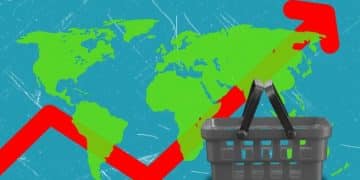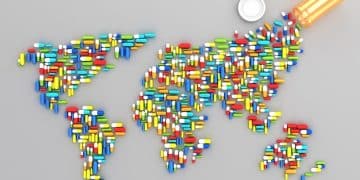Global Inflation in 2025: US Economic Stability at Risk?

The rising global inflation rate poses a significant challenge to US economic stability in 2025, potentially eroding purchasing power, escalating interest rates, and disrupting international trade balances, demanding proactive policy responses.
The global economy is a complex web, where a tremor in one corner can trigger a seismic shift elsewhere. As we look towards 2025, a critical question emerges: What the Rising Global Inflation Rate Means for US Economic Stability in 2025? This isn’t merely an academic exercise, but a pressing concern that touches everything from household budgets to international trade policies.
Understanding the Global Inflationary Landscape
Global inflation is not a monolithic phenomenon, but rather a confluence of localized pressures and interconnected economic forces. In the aftermath of significant global events, supply chain disruptions, shifts in consumer demand, and unprecedented fiscal and monetary policies have created an environment ripe for price increases across borders. This initial surge, often dismissed as transitory, has demonstrated remarkable persistence, embedding itself more deeply into economic structures than initially anticipated.
Several key factors contribute to this pervasive inflationary trend. Energy prices, for instance, remain a significant driver, with geopolitical tensions and production constraints keeping oil and gas benchmarks elevated. This directly impacts transportation, manufacturing, and ultimately, the cost of goods for consumers worldwide. Similarly, food commodity prices have seen sustained increases, driven by weather events, agricultural supply chain bottlenecks, and rising input costs such as fertilizers.
Supply Chain Vulnerabilities and Geopolitical Stressors
The fragility of global supply chains, exposed during recent crises, continues to fuel inflationary pressures. Any disruption, be it from natural disasters, labor shortages, or political conflicts, propagates rapidly through interconnected manufacturing and distribution networks. This leads to increased lead times, higher shipping costs, and ultimately, higher prices for consumers.
- Energy Price Volatility: Geopolitical events and OPEC+ decisions significantly influence global oil and gas prices, affecting virtually every sector.
- Food Supply Shocks: Climate change impacts and regional conflicts introduce instability in agricultural markets, pushing food prices upward.
- Labor Market Dynamics: Wage demands in key manufacturing hubs and logistical centers contribute to higher operational costs for businesses.
Moreover, geopolitical tensions, such as trade disputes and regional conflicts, can exacerbate these issues by limiting access to critical resources, imposing tariffs, and creating uncertainty that deters investment. These stressors not only affect the immediate flow of goods but also encourage nations to reconsider their supply dependencies, potentially leading to less efficient, more costly localized production in the long run.
In essence, the global inflationary landscape is characterized by a complex interplay of demand-side stimulus and persistent supply-side constraints. Understanding these underlying mechanics is crucial for anticipating how these trends will translate into challenges for the US economy as 2025 approaches.
Direct and Indirect Channels: How Global Inflation Reaches the US
The US economy, while robust and largely self-sufficient, is far from immune to global economic currents. The rising tide of international inflation impacts the US through both direct and indirect channels, influencing everything from import costs to investment flows. Recognizing these transmission mechanisms is vital for policymakers and businesses seeking to navigate the economic landscape of 2025.
Directly, the most obvious impact comes through imported goods. When inflation rises in countries that supply the US with everything from electronics to apparel, those higher costs are often passed on to American consumers and businesses. This “imported inflation” can contribute significantly to the domestic Consumer Price Index (CPI), making everyday items more expensive even if domestic production costs remain stable.
Imported Goods and Supply Chain Costs
The globalized nature of modern manufacturing means that few products are entirely “made in America.” Components, raw materials, and finished goods sourced from abroad are all subject to inflationary pressures in their countries of origin. This phenomenon is particularly acute in sectors heavily reliant on international supply chains, such as technology, automotive, and retail.
- Raw Material Price Spikes: Increases in global commodity prices (metals, plastics, rare earths) directly elevate manufacturing costs for US firms.
- Finished Goods Inflation: Consumer goods imported from countries experiencing high inflation become more expensive on US shelves.
- Logistics and Shipping Costs: Global fuel price hikes and shipping bottlenecks translate into higher freight charges, adding to the cost of imports.
Indirectly, global inflation can influence US financial markets and investor sentiment. If other major economies are struggling with runaway prices, it can lead to increased global interest rates as central banks tighten monetary policy. This, in turn, can make borrowing more expensive for the US government and American businesses, potentially slowing investment and economic growth.
Furthermore, a strong dollar, often seen as a safe haven during global instability, can temporarily mitigate imported inflation by making foreign goods cheaper in dollar terms. However, an excessively strong dollar can also harm US exports by making them more expensive for international buyers, creating a trade imbalance. The nuanced interaction of these direct and indirect channels makes predicting the exact impact complex, requiring careful monitoring.
The Fed’s Dilemma: Balancing Domestic Stability and Global Pressures

The Federal Reserve bears the dual mandate of maintaining maximum employment and stable prices domestically. However, in an increasingly interconnected world, achieving these goals is inextricably linked to global economic conditions. As global inflation continues its ascent, the Fed faces a profound dilemma: how to calibrate its monetary policy to safeguard US economic stability without inadvertently exacerbating global issues or undermining its own objectives.
A primary concern for the Fed is the risk of imported inflation becoming entrenched in domestic expectations. If consumers and businesses anticipate sustained price increases due to global factors, it can lead to a wage-price spiral, making inflation much harder to tame. The Fed’s response typically involves adjusting interest rates, but this is a blunt tool with far-reaching consequences.
Monetary Policy Tools and Their Global Ramifications
Increasing interest rates can help cool domestic demand and bring inflation down, but it also strengthens the dollar, makes US exports less competitive, and can place financial strain on countries with dollar-denominated debt. Conversely, keeping rates too low risks allowing inflationary pressures to build, undermining confidence in the dollar and potentially leading to asset bubbles.
- Interest Rate Hikes: Can curb domestic inflation but potentially strengthen the dollar, affecting trade balances and emerging market debt.
- Quantitative Tightening: Reducing the Fed’s balance sheet impacts global liquidity and capital flows.
- Forward Guidance: Communicating future policy intentions influences global market expectations and investment decisions.
Moreover, the Fed must consider the synchronicity of global monetary policy. If other major central banks are tightening aggressively, the Fed may have less room to maneuver independently. A divergence in policy can lead to significant capital flows, currency volatility, and challenges in coordinating international economic stability efforts.
The delicate balancing act involves carefully assessing whether global inflation is primarily a supply-side phenomenon—which monetary policy has limited power to address—or if it is translating into broader demand-driven inflation domestically. The Fed’s communication and actions in 2025 will be crucial in shaping market expectations and steering the US economy through these turbulent global waters, striving to prevent external shocks from destabilizing domestic prosperity.
Impacts on US Households and Businesses
The abstract concept of “global inflation” quickly becomes a tangible reality for US households and businesses. Rising prices, whether originating from domestic or international sources, erode purchasing power for consumers and squeeze profit margins for companies. Understanding these micro-level impacts is essential for comprehending the broader challenge to US economic stability in 2025.
For average American households, the most immediate effect is a reduction in disposable income. Higher costs for essentials like food, energy, and transportation mean less money available for discretionary spending, savings, or investment. This can lead to a slowdown in consumer spending, which is a major driver of the US economy. Furthermore, inflation can disproportionately affect lower-income households, who spend a larger percentage of their income on these essential goods and services.
Erosion of Purchasing Power and Cost of Living
The persistent rise in the cost of living due to global inflationary trends means that every dollar buys less than it used to. This can necessitate changes in lifestyle, delaying major purchases, and even reconsidering retirement plans for some individuals.
- Food and Fuel Bills: Households face higher expenses for daily necessities, directly impacting their quality of life.
- Mortgage and Loan Costs: Rising interest rates, a common Central Bank response to inflation, make borrowing more expensive for homes, cars, and education.
- Wage-Price Gap: If wages do not keep pace with inflation, real income declines, leading to a decrease in living standards.
Businesses, too, face significant headwinds. Increased costs for raw materials, energy, and imported components directly impact their supply chains and operating expenses. Smaller businesses, with less pricing power and thinner margins, are particularly vulnerable. They may struggle to absorb these higher costs, leading to difficult decisions regarding pricing, staffing, or even continuity.
Large corporations, while potentially better positioned to pass costs onto consumers, also face strategic challenges. They must navigate a complex landscape of fluctuating input costs, uncertain consumer demand, and potential labor unrest if wages fail to keep up with inflation. The cumulative effect of these pressures on both consumers and businesses can dampen overall economic activity, increasing the risk of slower growth or even recession in 2025.
Global Inflation and the US Labor Market in 2025
The US labor market, having shown remarkable resilience in recent years, faces new complexities due to persistent global inflation as we head into 2025. The interplay between rising prices, wage growth, and employment levels creates a dynamic environment that policymakers and employers must carefully navigate. Global inflationary pressures can significantly influence the bargaining power of workers, the profitability of businesses, and the overall stability of the labor force.
One of the primary concerns is the potential for a “wage-price spiral,” where workers demand higher wages to offset the rising cost of living, prompting businesses to raise prices further, which in turn fuels more wage demands. While not a certainty, prolonged global inflation increases the risk of such a cycle taking hold, making it harder for the Federal Reserve to bring inflation back to its target.
Wage Demands and Sectoral Pressures
Certain sectors, particularly those with strong union representation or persistent labor shortages, may see more pronounced wage growth. However, if this growth outpaces productivity gains and is simply a reaction to inflation, it can lead to reduced corporate profitability and potentially stifle job creation in the long run.
- Sector-Specific Shortages: Industries like healthcare, technology, and skilled trades may experience higher wage pressures due to demand outstripping supply.
- Union Bargaining Power: Organized labor may leverage high inflation to secure more significant wage increases and cost-of-living adjustments (COLAs).
- Worker Expectations: Employees, observing rising prices, are more likely to seek higher compensation, irrespective of actual productivity gains.

Global inflationary pressures also indirectly affect the US labor market through their impact on international trade and investment. If global economic growth slows due to widespread inflation, demand for US exports may weaken, potentially leading to job losses in export-oriented industries. Conversely, if foreign capital flows into the US as a safe haven from global instability, it could stimulate certain sectors, creating job opportunities.
The Federal Reserve’s response to global inflation also plays a critical role. Higher interest rates, intended to cool inflation, can also cool the labor market, potentially leading to slower job growth or even an increase in unemployment. Balancing the need to control prices with the goal of full employment will be a defining challenge for monetary policy in 2025, with direct implications for every American worker.
Geopolitical Impact and Investment Shifts
The rising global inflation rate is not solely an economic phenomenon; it is deeply intertwined with geopolitical dynamics and has significant implications for international investment patterns. As we approach 2025, the US economic stability will increasingly be influenced by how these global inflationary pressures reshape alliances, trade agreements, and capital flows across borders.
Geopolitical tensions, such as conflicts or trade disputes, can exacerbate global inflation by disrupting supply chains, increasing energy costs, and creating policy uncertainty. This, in turn, can prompt investors to re-evaluate their portfolios, seeking safer havens or opportunities in less volatile markets. The US, with its relative political stability and robust financial markets, often benefits from such “flight to safety” capital flows, but this also comes with its own set of challenges, including potential currency appreciation that could hurt exports.
Shifting Investment Narratives and Supply Chain Reshoring
Persistent global inflation can accelerate trends like reshoring or friend-shoring, where companies move production closer to home or to allied nations to mitigate supply chain risks. While this could stimulate domestic manufacturing and job creation in the US, it also implies higher production costs and potentially higher prices for consumers in the short to medium term as new supply chains are established.
- Capital Flight to Safety: Global instability and inflation can drive foreign investment into US assets, bolstering the dollar.
- Trade Realignments: Nations may seek new trading partners or strengthen existing blocs to secure essential goods and reduce inflationary dependencies.
- Strategic Resource Competition: Increased competition for critical raw materials (e.g., rare earths, energy) can intensify geopolitical rivalries and drive up prices.
Moreover, global inflation can place significant strain on countries with high levels of dollar-denominated debt. As the Fed potentially raises interest rates to combat domestic inflation, the cost of servicing this debt increases for many developing nations. This can lead to sovereign debt crises, which in turn can trigger wider financial instability and affect global trade, ultimately impacting the US economy through reduced export demand and increased market volatility.
The intricate dance between global inflation, geopolitical events, and investment capital flows means that US economic stability in 2025 will hinge not just on domestic policy, but also on astute diplomatic engagement and contingency planning to navigate an increasingly complex and unpredictable international landscape. The ability to anticipate these shifts and respond proactively will be paramount.
Strategies for US Economic Resilience in an Inflationary World
Facing the rising tide of global inflation in 2025, the United States must implement a multi-faceted approach to bolster its economic resilience. This involves a strategic combination of domestic policy adjustments, international collaboration, and forward-thinking economic planning. The goal is not merely to react to inflationary pressures but to proactively build a more stable and adaptable economy that can withstand future shocks.
Domestically, efforts to enhance supply chain resilience are paramount. This includes incentivizing reshoring or nearshoring of critical manufacturing, investing in infrastructure to improve logistics, and diversifying sources for key raw materials. Reducing dependencies on single-point failure suppliers or geopolitically unstable regions can significantly mitigate the impact of external price shocks.
Policy Levers and Innovation Boost
Fiscal policy can play a crucial role in managing demand without stifling growth. Targeted investments in productivity-enhancing technologies and human capital development can increase the economy’s capacity to produce goods and services more efficiently, thereby counteracting inflationary pressures in the long run. Monetary policy, guided by the Federal Reserve, will need to remain agile, balancing inflation control with employment goals.
- Supply Chain Diversification: Reduce reliance on singular sources for critical components to minimize disruption risks.
- Renewable Energy Investments: Lessen dependence on volatile fossil fuel markets by accelerating the transition to domestic clean energy.
- Skilled Workforce Development: Address labor shortages in key sectors through education, training, and immigration reform to boost productivity.
Internationally, the US can leverage its diplomatic influence to promote greater transparency and cooperation in global trade. Working with allies to address trade imbalances, coordinate monetary policies, and develop collective solutions to shared economic challenges can help stabilize global markets and reduce the transmission of inflation. This includes engaging in dialogues about global reserve currencies, sustainable development, and fair labor practices.
Encouraging innovation across all sectors will also be vital. Technological advancements can lead to increased efficiency, lower production costs, and the creation of new industries, all of which contribute to long-term price stability. By combining strategic domestic policies with active international engagement and a commitment to innovation, the US can strengthen its economic foundations and navigate the challenges posed by rising global inflation in 2025 more effectively.
| Key Point | Brief Description |
|---|---|
| ⚡️ Imported Inflation | Higher international prices for goods and components directly raise US costs. |
| 📊 Fed’s Balancing Act | The Federal Reserve must manage domestic inflation without causing global financial instability. |
| 🏠 Household Impact | Erosion of purchasing power and higher cost of living for US consumers. |
| 🌍 Geopolitical Interplay | Global conflicts and trade shifts impact supply chains and investment flows to the US. |
Frequently Asked Questions About Global Inflation
Global inflation refers to a sustained increase in the general price level of goods and services across multiple countries, driven by shared international factors like energy costs or supply chain issues. Domestic inflation focuses solely on price increases within a single country’s borders, which can be influenced by both internal and global factors.
For US consumers, global inflation translates to higher prices for imported goods, from electronics to clothing, and increased costs for globally traded commodities like oil and food. This effectively reduces their purchasing power and raises the overall cost of living, even if their wages remain constant, making everyday expenses more burdensome.
The US dollar often acts as a “safe haven” during periods of global economic uncertainty and inflation, leading to its appreciation against other currencies. While a stronger dollar can make imports cheaper for US consumers, it simultaneously makes US exports more expensive, potentially harming American businesses that rely on international sales and creating trade imbalances.
The Federal Reserve can influence the domestic impact of global inflation through monetary policy tools like interest rate adjustments. However, it cannot directly control external factors such as global energy prices or geopolitical supply disruptions. Its role is to mitigate the effects and prevent imported inflation from becoming entrenched in domestic economic expectations.
Sectors heavily reliant on imported raw materials or components, such as manufacturing and technology, are highly vulnerable. Similarly, industries dependent on global energy prices or international shipping, like transportation and logistics, face significant cost pressures. Consumer-facing sectors are also impacted as higher input costs ripple through the supply chain.
Conclusion
The trajectory of global inflation casts a long shadow over the future of US economic stability in 2025. Far from being an isolated economic phenomenon, rising global prices are deeply integrated with supply chain vulnerabilities, geopolitical tensions, and the intricate dance of international finance. For the US, this means a continued struggle against imported inflation, delicate monetary policy choices for the Federal Reserve, and mounting pressures on both households’ purchasing power and businesses’ profitability. Navigating this complex landscape will demand not only adaptive domestic strategies focused on supply chain resilience and productivity growth but also robust international diplomacy to foster stability and cooperation. The ability of the US to maintain its economic footing will ultimately depend on a concerted effort to manage these interconnected global challenges proactively and strategically, ensuring that the ripple effects of international economic turmoil do not undermine foundational prosperity at home.





